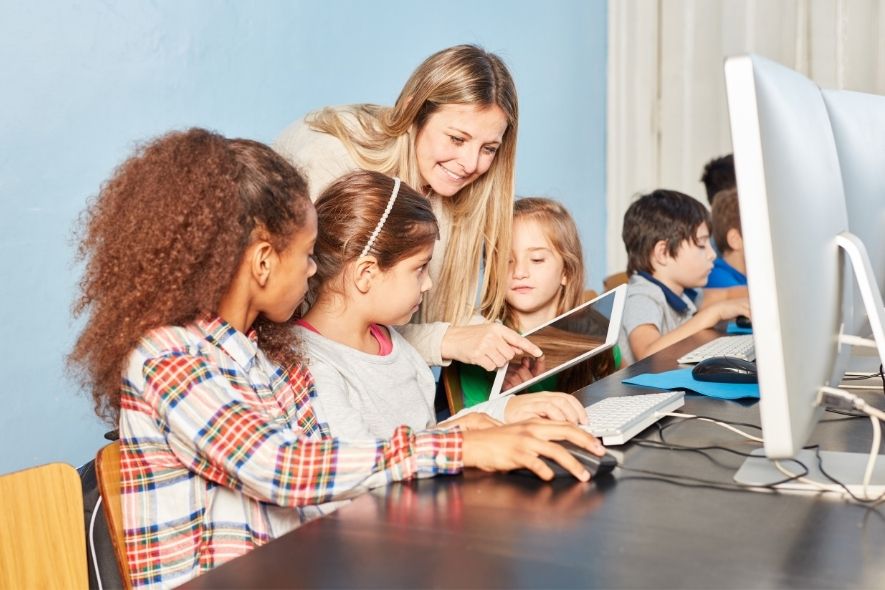Before scrolling down, imagine for a moment, what will the world be like 20 years or so from now? What kind of jobs will the students you are teaching now be doing? Think about what life was like 20 years ago and all the changes you have seen happen. Then imagine what will happen in the next 20 years.
The future of work needs the 7Cs
A few years ago, a student told me in a career counseling session that he would like to become an E-sports player in the future. I was intrigued by this back then: a “new” career option he was passionately telling me a lot of interesting ideas about this career goal. It is fascinating to see the abundant new career opportunities in the 21st century booming beyond our imagination.
To give you an idea, the following jobs have emerged only since the year 2000: social media manager, digital content creator, UX designer, cyber security consultant, and many more. Together with the growth of slash career and attaining entrepreneurship is becoming increasingly easier, the working culture in the 21st century is quickly evolving and definitely very different from the past.
By one popular estimation, 65% of our children entering primary school today will ultimately end up with completely new job types that don’t even exist yet. To think a bit more, a baby born today will be in his/her 30s in 2050. If all goes well, the baby will still be around in 2100 and might be an active citizen of the 22nd century. These facts remind me of the famous quote from John Dewey, who is an influential philosopher and educational reformer:
“If we teach today’s students as we taught yesterday’s, we rob them of tomorrow.”
Being educators in this century, how do we best prepare our young people for a future of work that doesn’t exist yet, careers that have not yet been invented, and a world of unprecedented transformations and radical uncertainties? How can we teach the skills that are needed to enable them to navigate and flourish in the world of 2030, 2050, or of the 22nd century as responsible citizens living a fulfilling life? Are you pondering similar questions? I guarantee that you are not alone to look for the answers to these big questions! Let’s discover the 7Cs in education to bring you onto the right path.
From 4Cs to 7Cs

The 21st-century skills movement emerged at the beginning of this century. Since 2002, the Partnership for 21st Century Skills (P21) has been the leading advocacy organization in the United States focused on infusing 21st-century skills into education. The famous 4Cs framework developed by the P21, may not be novel to you nowadays, is a pioneer to call for education that develops critical thinking, communication, collaboration, and creativity to prepare young people for citizenship and the workforce in the global society. This movement has been transforming school curricula around the world aiming to develop young people’s strong mastery of content knowledge, as well as the acquisition of a variety of soft skills.
The changes of the world didn’t stop in 2002, so do the skills that we need. The 4Cs framework is soon expanded into the 7Cs to address the fundamental changes to lifestyles, knowledge acquisition, and ways of thinking in the 21st century. In 2009, 2 experts from the P21, Bernie Trilling and Charles Fadel published a book “21st-century skills: Learning for Life in Our Times”. They broaden the 4Cs to 7Cs, in response to the increasingly ubiquitous digitalized and mediated environment.
To show you what I mean, let’s think about how our habits of listening to music have changed in the last 20 years. While the earliest streaming service was invented just about 20 years ago, as of the first quarter of 2021, global streaming music subscribers have risen to 487 million! New opportunities also come along: creating and sharing music has never been as easy as now! As a result, competencies of analyzing digital resources, using digital tools to create and share then become the newly added prominence in the 7Cs framework. By the same token, analyzing the megatrends and the rapidly changing digital landscape in the 21st century, Bernie and Charles put forward a new version of the 21st-century skills, which encompasses 7 core competencies starting with the letter C.
So, what are the 7Cs in education?
The 7Cs of the 21st-century learning

According to Bernie and Charles, the 7Cs are as important as content knowledge in the curricula we teach daily. These competencies are skills that employers, the workplace, and modern society are looking for in the 21st century. If we believe our work as teachers is mainly to prepare students for a successful and fulfilling future, we should give opportunities to our students to strengthen these skills across content areas.
The 7Cs are: Critical thinking, Creativity, Collaboration, Communication, information, and media literacy, Computing and ICT literacy, Cross-cultural understanding, and Career and learning self-reliance.
Critical thinking
The ability to solve problems and reason effectively.
The work culture is increasingly demanding flexible analytical skills, therefore, being able to analyze and reason effectively and integrate diverse sources of information systematically into problem-solving is a huge strength in any career.
Creativity
The ability to think creatively, to work creatively with others, and to implement innovations.
The 21st century demands continuously innovating new services, better processes, and improved products for the well-being of humans and the global economy. It is no surprise that creative work is highly valued.
Collaboration
The ability to cooperate, to compromise, to achieve consensus, and to build community.
Collaboration is the nature of how work is accomplished in our civic and work lives. Much of the significant work is accomplished in teams, and nowadays, global teams.
Communication, information, and media literacy
The ability to communicate clearly and effectively in a diverse environment; access and evaluate information, and analyze, use, and create media effectively.
The power of the media and the ubiquity of communication technologies in all aspects of life make strong communication skills even more important. The ability to effectively analyze and process the overwhelming amount of communication and media content is immensely needed in many careers.
Computing and ICT literacy
The ability to apply technology effectively and ethically
Successful modern businesses and organizations rely heavily on technologies to operate. Knowing how to apply suitable technology will significantly benefit your life and career path.
Cross-cultural understanding
The ability to minimize barriers across diverse ethnic groups, cultures, and ideas, such as preconceptions, prejudices, and stereotypes that distort our understanding of other people and hinder us from working effectively and creatively with team members regardless of the diverse differences.
Understanding and accommodating cultural and social differences, and using these differences to come up with even more creative ideas and solutions to problems, will be increasingly important throughout this century. Cross-cultural interaction skills both online and face-to-face in the international working environment are more important than ever.
Career and learning self-reliance
The ability to navigate the complex life and work environments in the globally competitive information age and to manage changes. The capacity to commit to lifelong learning for developing adequate life and career skills.
In a rapidly changing world full of uncertainties, committing to lifelong learning builds the resilience to adapt to changes. Every career path requires constant updating of skills and knowledge in the 21st century.
The 7Cs in education give opportunities to bridge our everyday teaching and school education with what our young people will need when they are out in the world.
5 ways to bring the 7Cs into teaching and learning

Now that you understand what the 7Cs are and how important they are, you may start wondering, how do we integrate them into our teaching and learning? Normally, some teachers may feel a bit overwhelmed, but rest assured, when we implement the 7Cs, we are not doing extras, we are just doing things differently. Read the 5 ways below and you will know what I mean.
Shifting mindset of what means teaching
What do we mean by teaching in the 21st century? Take a look at the new balance below (adapted from Trilling and Fadel, 2009):
21st-century learning – a new balance between:
| Teacher-directed | Learner-centered |
| Direct instruction | Interactive exchange |
| Knowledge | Skills |
| Content | Process |
| Basic skills | Applied skills |
| Facts & principles | Questions and problems |
| Theory | Practice |
| Curriculum | Projects |
| Time-slotted | On-demand |
| One-size-fits-all | Personalized |
| Competitive | Collaborative |
| Classroom | Global community |
| Text-based | Web-based |
| Summative tests | Formative evaluations |
| Learning for school | Learning for life |
Don’t get me wrong, when we implement the 7Cs in education, we don’t completely wipe off the list on the left of this table, instead, we are shifting our pedagogical practices toward a new balance, leaning more to the right side of the table. The new balance is not a “yes-no”, nor “either-or” concept, but a spectrum, a continuum that blends both approaches. Focusing on applied skills doesn’t mean abandoning the teaching of basic skills and knowledge. 21st-century teaching and learning mean striking the right balance of pedagogical approaches for your students.
Implementing the 7Cs in education starts from teachers’ mindsets. As one teacher put it, “I had to unlearn the idea that teaching was about my content; I had to learn it was about their thinking and their skills.” The shift in our mindsets motivates us to look for pedagogies that focus on developing students’ thinking and skills, on top of the content being taught.
Invite questions, not answers
Using questions effectively is the key to responsible, active, resourceful, democratic citizenship in the 21st century. Therefore, nurturing students’ ability to question is fundamental to envisioning that future. The classroom has been described as the cradle of democracy, and the teacher is one of the most influential nurturers of the democratic process. Think for a moment, to what extent do your classroom practices encourage questioning and reasoning? When you are asking a question, do you normally expect students to give some “correct” or “expected” answers, or do you expect to spark their curiosity to ask you questions?
Isn’t it normal to expect an answer when we are asking questions? Partly true. If we aim to develop students’ critical thinking skills and creativity, the functions of our questions will be different from when we aim to check students’ understanding of specific knowledge. Why we ask a question would determine how we ask the question! As a result, the responses we invite will also be different.
Changing the way you ask questions will certainly transform your classroom into an active place for inquiry, discussion, questioning, debates, and all of these contribute to building students’ 7Cs.
If you would like to deep further into this topic we have written two blog articles: “Use Questions Effectively: How To for Asking the Right Ones” and “Use Questions Effectively: Why Ask?“.
Create opportunities for connection

According to connectivism, learning in this digital age is a process of developing networks and connections. Knowledge is created through connection, particularly with digital technologies. Think about your own experience of learning something new from social media, online networks, blogs, or information databases. Almost all of us nowadays are learning from accessible networks where people are happy to share their knowledge. In the information age, the huge amount of data means that no one is able to know all, we need to communicate and collaborate in order to succeed together.
To prepare our students to interact and collaborate in this globally connected world, we need to promote collaborative learning, such as group collaboration, discussion, allowing different viewpoints and perspectives for decision making, problem-solving, and making sense of information. Creating opportunities for connection in real life and the online arena would help students to develop their competence to collaborate and communicate in a diverse environment, as well as their information and media literacy. How often in your class, students get to interact and collaborate with their classmates, communities, and online networks? Creating opportunities for connections in your teaching will facilitate students to acquire the 7Cs!
Authentic problem solving
Solving authentic problems is a learning adventure that deepens understanding, hones skills, provides emotional satisfaction, ignites creativity to reveal new ways to work and learn.
Learning methods that provoke authentic problem-solving include, for example, inquiry learning, design-based learning, and project-based learning. All these pedagogies bring forward authentic, complex questions, problems, or challenges in the real world that are relevant to students’ real lives. When students are engaged to solve real-world problems, not only they will learn the knowledge, but also learn the application of the knowledge. By then, the knowledge for students will become more than just a grade on a paper, but relevant, practical, and useful in real-world and daily lives. By implementing these student-centered pedagogies, our students will be well-prepared to become problem solvers in any career.
Formative and sustainable assessment

Lifelong learning is an increasingly essential competence to live a fulfilling life in the 21st century. Learning knowledge and new skills throughout our whole life is beneficial to our career development and overall well-being. Studies have found that it can improve our self-esteem and life satisfaction, alleviate stress and anxiety when face changes.
So, how do we prepare our students to become lifelong learners? Formative assessment and sustainable assessment are effective tools to help them develop the capacity for self-directed learning and self-regulation: formative assessment aims to provide feedback that guides learners to reach their goals (assessment for learning), while sustainable assessment, which derives from the concept of sustainable development, aims to help learners to meet their future learning needs beyond the time scale of a given course or program, by the use of ongoing self-assessment by students to monitor their learning (assessment as learning).
Formative assessment is usually done by teachers or peers, sometimes the learners themselves, while sustainable assessment is often done by the learners themselves with suitable tools provided. For formative assessment strategies and tools, I recommend you to read this or this.
For sustainable assessment, which is part of formative assessment, teachers usually provide students with suitable assessment tools, such as rubrics that clearly describe the observable learning performance and invite the students to make reasonable evaluations and judgments on their learning performance.
To what extent does your school emphasize assessment for learning and assessment as learning? How are you going to implement them in your teaching to help your students to develop their career and life skills?
Conclusion
We may not have a magical crystal ball to see the future, but have you heard of the saying “The best way to predict the future is to create it”? By implementing the 7Cs into our education, we are now sketching a picture of the future world together!
What are your thoughts about the 7Cs in education? How is your experience of implementing 7Cs into teaching and learning? Share with us your thoughts, experience, and questions in the comment box below! We are happy to hear your stories and learn together!
If you want to know more about the 7Cs, I have recently designed a one-week teacher training course: The 7Cs: Learning for Life (and Work) in the 21st Century


Love Greetings to all of you
Thank you all for your super brilliant efforts to succeed the educational process, I love what you are working on and my idea is to have a good outcome we have to concentrate on puting a good income same way as farmers does with the ground preparation process.
All the best
Nader Almgadmi
I consider that the implementation of the 7Cs in education depends a lot on the society where it is applied. Many societies and governments are still not prepared and developed so that these new generations of children equipped with powerful tools can have a new vision about education. Nowadays we want urgent changes in terms of climate and national security, but in most European corporate governments an old mentality still persists. The new politicians have to appear and change the current mentality. In my educational practice I try to challenge students to think outside the box and overcome difficulties. In fact these new young people will be our future politicians.
I believe that the implementation of “The 7Cs of the 21st-century learning”, will be the future of education in the world. The most important steps are those taken when students are very young. Respecting the development of children is very important. and in this aspect many societies are still very far behind.
I really need more sources about students 7cs skills anyone please bring me there
Your topic is very interesting. Can I adopt it in our school?